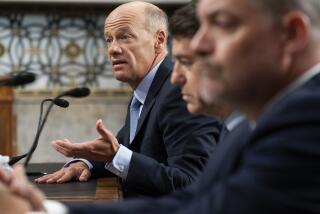Focus on Enron Shifting to Trials of Former Execs
- Share via
It was one of the more spectacular corporate bankruptcies ever: Enron Corp., once the seventh-largest company in the country, felled by intricate and illegal accounting tricks.
But as the disgraced company limped toward exiting Chapter 11 this year, the second-largest bankruptcy case in history behind WorldCom Inc. -- now called MCI Inc. -- seemed almost secondary as the public’s focus shifted to criminal proceedings against Enron founder Kenneth L. Lay and former Chief Executive Jeffrey K. Skilling.
Both were indicted this year and pleaded not guilty to charges that include conspiracy and fraud. They are awaiting trial.
The bankruptcy case has reduced the Houston-based former energy trading conglomerate first to an operator of pipelines and power plants, and ultimately to a holding company responsible for paying off debts.
“Shareholders are gone, and the company is different,” said David Skeel, a University of Pennsylvania bankruptcy law expert. “What people associate with Enron now is Lay and Skilling.”
As 2005 approaches, trial dates for Lay, Skilling and former Enron Chief Accounting Officer Richard A. Causey have not yet been set.
Skilling and Causey each face more than 30 counts, including fraud, conspiracy and insider trading, on charges of being in on various schemes to fool investors into believing that Enron was financially healthy so they could pocket millions from sales of inflated stock.
Lay faces seven counts of fraud and conspiracy on allegations of taking over leadership of the financial ruse upon Skilling’s resignation in mid-August 2001, less than three months before Enron crumbled into bankruptcy.
In a separate case, Lay is also charged with one count of bank fraud and three counts of lying to banks for allegedly misleading them about his intention to use $75 million in personal loans to buy Enron stock on margin.
But first, five former executives from Enron’s defunct broadband unit are scheduled to go to trial April 1. Three -- former unit Chief Executive Joseph Hirko, and former Vice Presidents Rex Shelby and F. Scott Yeager -- are accused of fraud, conspiracy, insider trading and other counts for allegedly touting the broadband network as having capabilities it didn’t have so they could sell shares of stock inflated on the hype.
The remaining two -- former accounting executives Kevin Howard and Michael Krautz -- are accused of faking $111 million in 2000-01 from a video-on-demand deal with Blockbuster Inc. that flopped.
Enron crashed in December 2001 upon revelations of partnerships and financing schemes that hid debt and inflated profit. In July, U.S. Bankruptcy Court Judge Arthur Gonzalez confirmed Enron’s reorganization plan, which aims to pay most creditors about one-fifth of the estimated $63 billion they’re owed.
The plan went into effect in mid-November, finally canceling nearly dead Enron stock and turning it into a private company. The same day, the company closed on the $2-billion sale of its most prized remaining assets -- whole or part ownership in three domestic natural-gas pipelines that employ about 1,200 people.
Still pending is a $1.25-billion sale of Portland General Electric, Enron’s Pacific Northwest utility, to a holding company backed by Texas Pacific Group.
A third company that hasn’t enticed serious buyers -- Prisma Energy International Inc. -- is no longer under Enron’s umbrella and operates a hodgepodge of pipeline and power assets with 4,700 employees in 14 countries under its own management.
Enron’s main business now is handling lawsuits, cooperating with investigations and eventual distribution of about $12.8 billion to creditors -- 92% in cash and 8% in stock in Prisma. If the Portland General sale falls through, creditors will receive less cash and stock in both Prisma and the utility.
Distributions are expected to begin in mid-2005, and the Enron name will linger as long as they and lawsuits need to be addressed, spokeswoman Jennifer Lowney said. About 500 workers -- including five new directors appointed by the disbanded creditors committee and one of the bankruptcy examiners -- remain for a company that once employed more than 20,000 worldwide.
If there are any winners in the bankruptcy case, it is the lawyers, consultants, accountants and other professionals, who have earned nearly $1 billion in fees.
More to Read
Inside the business of entertainment
The Wide Shot brings you news, analysis and insights on everything from streaming wars to production — and what it all means for the future.
You may occasionally receive promotional content from the Los Angeles Times.










